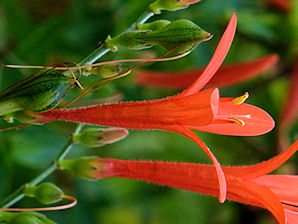Xeriscape Landscaping Plants For The Arizona Desert Environment.
Pictures, Photos, Information
Descriptions, Images, & Reviews.
Shrubs.
Flame Honeysuckle, Anisacanthus quadrifidus v. wrightii.
We Are Proud Of Our SafeSurf Rating!
Click On Any Of The Following Links By Amazon.Com
For Books, & Videos About Wildflowers Of Arizona & The Southwest USA. No Obligation!
| Flame Honeysuckle. Anisacanthus quadrifidus v. wrightii. All Photos Courtesy: Wikipedia, the free encyclopedia. |
|---|
 | |
| Flame Honeysuckle. Anisacanthus quadrifidus v. wrightii. | Flame Honeysuckle. Anisacanthus quadrifidus v. wrightii. |
|---|
 /
/

Flame Honeysuckle.
We wish to thank Wikipedia, the free encyclopedia for some of the information on this page. We share images and information with Wikipedia. Flame Honeysuckle is a hardy, perennial, deciduous, shrub that grows 4 to 5 feet tall and wide, with a rounded to irregular shape. Its red-orange tube-shaped flowers occur in terminal spikes on the main stems and short lateral stems. It blooms mainly in the summer and fall. The flowers attract hummingbirds and butterflies. It takes reflective heat, sun, or part shade and is hardy to 5� F. It is pool friendly since it has low litter and no thorns. If you allow the pods to dry on the plant, you can break them open to collect the seeds.
Quick Notes:
Height: Up To 4 to 5 feet tall and 4 to 5 feet wide.
Flowers: On 8 inch long spikes. Red - redish Orange, nearly 2 inches long, with a narrow tube and throat and spreading lobes.
Flowering Time: June to November.
Fruit: Spherical bur-like fruits, colored from gold, to purple, to brown. Covered with microscopic hairs, the fruit has 12 to 35 flat and straight spines which are 1/4 to 1/3 inches in length and scattered over the surface.
Leaves: Rich - green, about 2 inches long by 1 inch wide.
Found: Native to the Chihuahuan Desert, of southern Arizona through Texas from west Texas into south-central Texas (the southern Edwards Plateau) and into northeastern Mexico; Chihuahua, Coahuila, Nuevo Leon, & Tamaulipas. The USDA claims it is native to the USA (TX).
Hardiness:
Soil pH requirements:
Sun Exposure:
Elevation: Naturally found between 2,000 to 5,000 feet.
Habitat: Floodplains of streams, banks of streambeds shrublands (matorral), and grasslands. Does well in sandy desert soils, hot, sunny areas, with good drainage. Adapts to a wide variety of soils, such as well-drained sand, loam, clay, caliche, limestone; to from rocky slopes to open areas.
Miscellaneous: Photos Courtesy: Wikipedia, the free encyclopedia.
|



We Are Proud Of Our SafeSurf Rating!
Click On Any Of The Following Links By Amazon.Com
For Books, & Videos About Xerioscape Plants Of Arizona & The Southwest USA. No Obligation!
Back To Arizona Wild Flowers Home Page.
Back To Arizona Wild Flowers; Red Flowers Page Three.
Back To Arizona Wild Flowers; Orange Flowers Page Two.
Back To Arizona Xeriscape Landscaping Main Page.
Back To Xeriscape Shrubs Page Seven.
Back To DeLange Home Page
© 1966 - Present, Audrey, Eve, & George DeLange
| © 1966 - Present, Audrey, Eve, & George DeLange |


